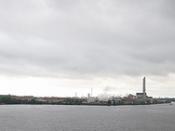The Fox River runs through Northeastern Wisconsin and empties into the Bay of Green Bay. People have long used the region for transportation, commerce, energy, food (fish and waterfowl) and recreation. A barge canal links the Fox and Wisconsin rivers at Portage, forming a continuous waterway from Lake Michigan to the Mississippi River. It was a well-known route used by early explorers, missionaries, and fur traders to reach the Northwest and the Mississippi River system from the Great Lakes. Today the terrestrial, wetland and aquatic habitats support a wide diversity of songbirds, shorebirds and waterfowl. The Fox River is 176 mi or 283 km long. Because of the water availability, a paper mill was established on the Fox River in Appleton in 1853. The paper industry grew to include 20 paper mills along the 37 miles of the Lower Fox River. This is believed to be the largest concentration of pulp and paper industries in the world.
In the mid-1950s, carbonless copy paper was developed and produced in these Paper Mills in the Lower Fox River valley. Carbonless copy paper was manufactured between 1954 and 1971, some paper mills de-inked and recycled the carbonless copy paper, which released PCBs into the Fox River. PCB's are found throughout the Fox River area in the air, soil, water, and wildlife. Humans can come into contact with PCB's by eating the animals from the bay area and breathing the contaminated air. It can also be absorbed through the skin by swimming in the polluted water or handing the polluted soil. The river and bay bottom sediments are badly contaminated with these toxic chemicals, called PCBs (polychlorinated biphenyls). As a result of these processes performed by Paper Mills, an estimated 70,000 pounds of PCBs were released into the Fox River. PCB's attach to the...


